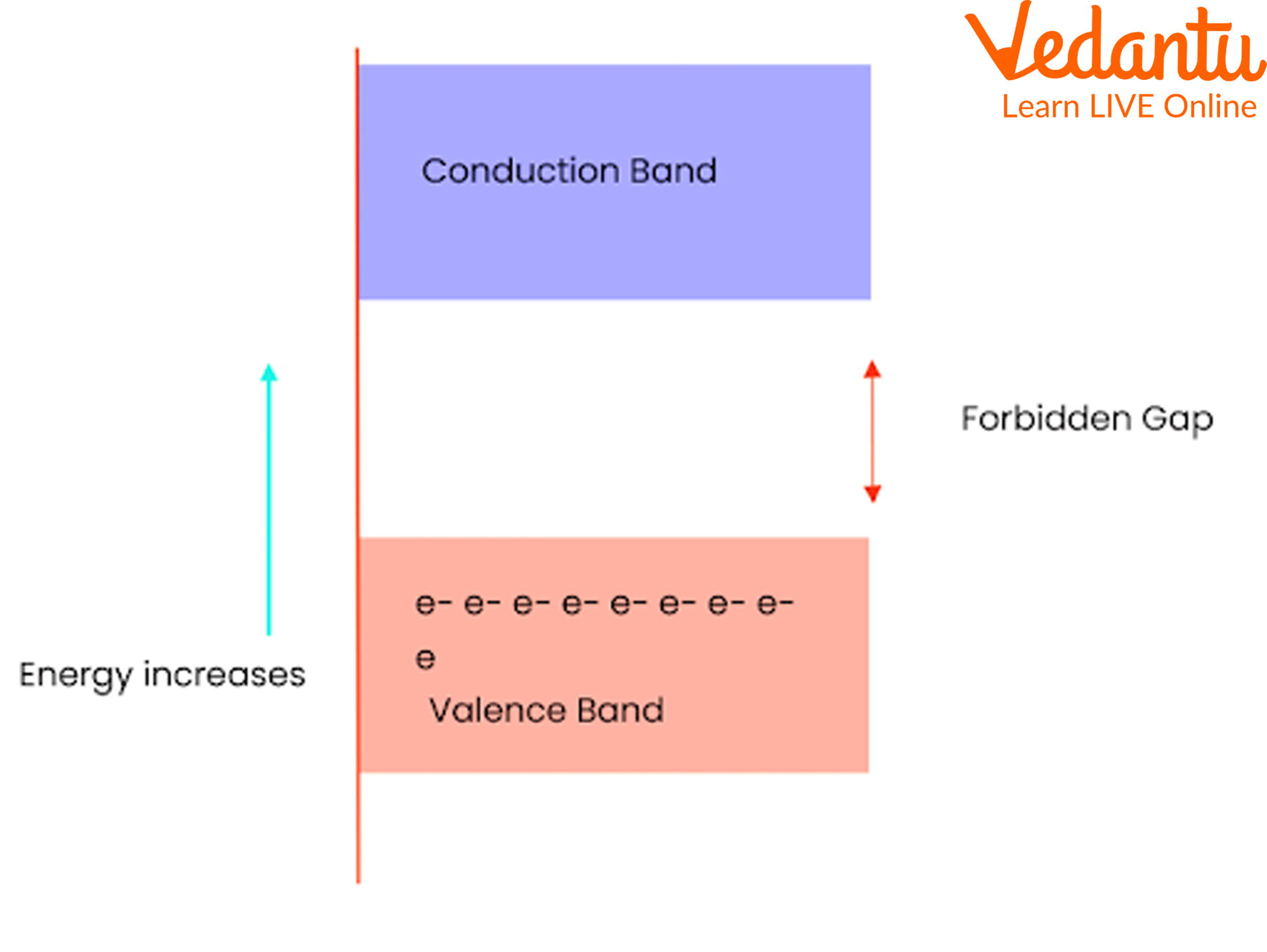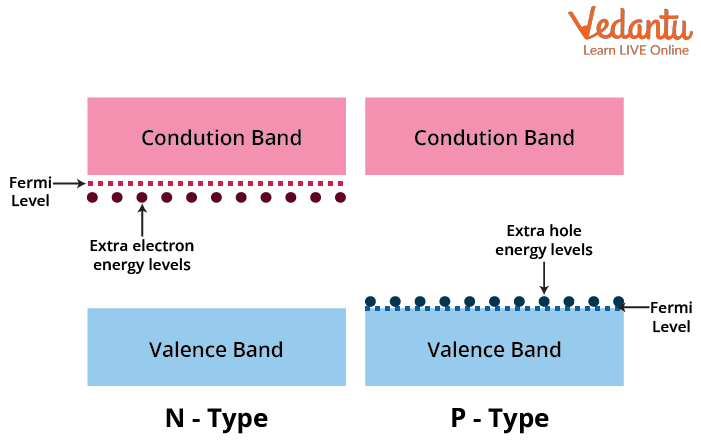




How Do Energy Bands Determine Conductors, Semiconductors, and Insulators?
The concept of energy bands is at the heart of understanding electrical properties of solids in JEE Main Physics. When atoms come together to form a solid, their individual electron energy levels combine and spread out into continuous bands. This explains why some materials conduct electricity, while others act as insulators or semiconductors. Knowing energy bands, band gaps, and related diagrams is vital for scoring in questions on solid-state physics, electronic devices, and semiconductor theory.
What Are Energy Bands? Fundamental Meaning and Need
In isolated atoms, electrons occupy discrete energy levels. However, in crystalline solids (arranged in a regular lattice), the outermost energy levels of atoms overlap, forming broad ranges called energy bands. The two main bands are the valence band (occupied by outer electrons) and the conduction band (where electrons can move freely and conduct electricity).
Band theory explains why metals, semiconductors, and insulators behave so differently. It bridges atomic physics and material science, crucial for modern electronics and JEE applications.
Formation of Energy Bands in Solids
Energy bands in solids are a consequence of atoms coming so close that their atomic orbitals overlap significantly. This leads to band splitting, where discrete energy levels split into closely spaced molecular orbitals, forming nearly continuous bands as the number of atoms becomes very large (typically ~1023 in 1 cm3).
- Single atom: clearly separated energy levels
- Small group of atoms: slight level splitting
- Bulk solid: so many levels overlap, forming energy bands
- The width of these bands depends on atomic separation and crystal structure

Types of Energy Bands: Valence, Conduction, and Forbidden Gap
In all solids, three parts appear in basic energy band diagrams: the valence band, conduction band, and the forbidden gap (also known as the band gap or forbidden energy gap). Each affects electrical properties differently.
| Band Type | Description | Role in Conductivity |
|---|---|---|
| Valence Band | Highest band filled with electrons at 0 K | Holds electrons tightly, no conduction unless electrons jump |
| Conduction Band | Band just above valence band | Electrons here move freely and conduct current |
| Forbidden Band (Band Gap) | Energy region where no electron states exist | Width determines if a material is conductor, insulator, or semiconductor |
The forbidden band gap (Eg) is zero in conductors, large (>5 eV) in insulators, and moderate (~1 eV) in semiconductors like silicon.
Energy Bands in Conductors, Insulators, and Semiconductors
A key JEE Main question is to distinguish electrical behavior using band diagrams. The difference in energy bands explains why copper is a metal, glass an insulator, and silicon a semiconductor.
| Material Type | Valence Band & Conduction Band | Band Gap Eg | Example |
|---|---|---|---|
| Conductor | Bands overlap; no forbidden gap | 0 eV | Copper (Cu), Silver (Ag) |
| Insulator | Wide forbidden gap; valence full, conduction empty | >5 eV | Glass, Diamond |
| Semiconductor | Narrow band gap; some electrons thermally excited | 0.7–1.5 eV | Silicon (Si), Germanium (Ge) |
The band gap in silicon (~1.1 eV) enables it to conduct under certain conditions, which is why it forms the basis of most electronic devices.
Intrinsic and Extrinsic Semiconductors: Band Structure and Doping
Pure (intrinsic) semiconductors like silicon or germanium have equal electrons and holes, with the Fermi level nearly halfway between the valence and conduction bands. When doped (extrinsic), donor or acceptor atoms introduce extra energy levels—n-type doping adds donor levels near the conduction band, while p-type doping adds acceptor levels near the valence band. This alters conductivity by shifting the position of the Fermi level.

- Intrinsic: Fermi level in the middle of band gap
- n-type: Fermi level shifts closer to conduction band
- p-type: Fermi level shifts closer to valence band
- Band diagrams change as impurity atoms change material properties
Band diagrams of intrinsic and extrinsic silicon are crucial for JEE questions on p-n junctions, diodes, and transistors. For comparison, see difference between p-type and n-type semiconductor.
Applications and Numerical Importance of Energy Bands
Energy bands play a fundamental role in all modern electronics. Devices such as diodes, transistors, solar cells, and LEDs are designed based on precise control of band gaps and carrier movement.
- Electronic devices rely on band gaps for switching and amplification
- Design of conduction band materials impacts efficiency in circuits
- Band gap engineering involves adjusting Eg for specific wavelengths in photonics
- Understanding energy bands is essential for resistance and temperature-dependence solving
A common friction point in numericals: ensure you use the correct value for the band gap of materials (e.g. for silicon, Eg = 1.1 eV). Electrons need at least this energy to jump from valence to conduction band and conduct electricity.
Energy Band Diagram Practice: JEE Main Solved Examples
Practicing with energy band diagrams can clarify differences between materials and solidify your understanding for exams. Here are sample questions that sharpen exam readiness:
- The energy band gap of silicon is 1.1 eV. A photon of energy 2 eV can create how many electron-hole pairs? Answer: Only one (as excess energy becomes kinetic).
- If the forbidden gap is 6 eV, is the material conductor, insulator, or semiconductor? Answer: Insulator (gap is much too wide for electron jumps at room temperature).
- Which material will conduct better at high temperatures—silicon or diamond? Answer: Silicon, due to lower band gap and higher carrier mobility.
- Sketch an energy band diagram for a conductor. Key Point: Valence and conduction bands overlap, so electrons move freely.
- The Fermi level lies at the center of the band gap in which type of semiconductor? Answer: Intrinsic semiconductor.
For stepwise MCQs and practice worksheets on band diagrams, visit electronic devices practice paper and classification of solids.
Summary: Mastering Energy Bands for JEE Main
Understanding energy bands allows JEE Main aspirants to predict and explain conductivity, material properties, and the basis of electronic components. Always relate diagram features (band overlap, gap width, Fermi level) directly to observable properties like conduction, insulation, or semiconductor response. Refer back to Vedantu’s in-depth notes and diagrams for clearer, faster revision before your exam.
- Energy bands explain why some solids are conductors, others are insulators
- Band gap width Eg is the key property; know typical values for JEE
- Band diagrams feature heavily in electronics, solid state, and device physics MCQs
To further deepen your understanding, check related concepts like solid state, fermi energy, and properties of solids.
FAQs on Energy Bands: Concept, Diagram & Applications
1. What is an energy band in physics?
An energy band is a range of energy levels that electrons can occupy in a solid. These bands are formed due to the overlap and splitting of atomic orbitals in a crystal lattice.
- Explains electrical properties of conductors, semiconductors, and insulators
- Key concept in solid-state physics and energy band theory
- Fundamental for understanding why some materials conduct electricity and others do not
2. How do energy bands form in solids?
Energy bands in solids form when individual atomic energy levels merge and split due to close atomic packing in a crystal lattice.
- Atoms in solids are closely packed, causing their outer energy levels (orbitals) to overlap
- This overlap leads to the formation of closely spaced energy levels, creating two primary bands: the valence band and the conduction band
- The process explains the electronic properties of materials
3. What is a forbidden energy band?
A forbidden energy band (or band gap) is the range of energy between the valence band and conduction band where no electron states exist.
- Electrons cannot occupy energy levels in the forbidden band
- Size of the forbidden gap determines if a material is a conductor, semiconductor or insulator
- Also called the band gap (Eg)
4. How are energy bands different in conductors, semiconductors, and insulators?
The distinction lies in the arrangement and gap between the valence band and conduction band.
- Conductors: Valence and conduction bands overlap, so electrons move freely, making them good at conducting electricity.
- Semiconductors: A small forbidden gap exists (~1 eV); electrons can move to conduction band when provided energy (e.g., thermal energy).
- Insulators: A large forbidden gap (>3 eV); electrons cannot easily jump to the conduction band, restricting conduction.
5. Why are energy bands important in semiconductors?
Energy bands determine how semiconductors conduct electricity and enable their use in electronic devices.
- The small band gap allows electron promotion with little energy input
- Key to transistor, diode, and integrated circuit function
- Explains intrinsic and extrinsic conduction properties
6. What is the energy band diagram for silicon?
The energy band diagram for silicon shows the valence band just below the conduction band, with a forbidden gap of about 1.1 eV at room temperature.
- Fermi level is near the middle of the gap for intrinsic silicon
- Diagram illustrates differences between conductors, semiconductors, and insulators
- Shows how doping can change the position of the Fermi level
7. What is the significance of the forbidden energy gap?
The forbidden energy gap decides a material’s electrical properties and its usability in devices.
- Smaller gap: easy electron transition, higher conductivity (as in semiconductors)
- Larger gap: poor conductivity (as in insulators)
- Enables control over electronic behaviour by applying voltage or adding impurities (doping)
8. How does doping affect energy bands in semiconductors?
Doping introduces extra energy levels (donor or acceptor states) near the conduction or valence bands.
- Increases conductivity by providing extra charge carriers
- Changes the position of the Fermi level
- Makes materials either n-type (extra electrons) or p-type (extra holes)
9. Can energy bands exist in non-crystalline solids?
Energy bands can exist in non-crystalline (amorphous) solids, but they are less defined than in crystalline materials.
- Presence of disorder leads to localized states within the band gap
- Electrical properties differ from those of pure crystals
- Relevant for amorphous silicon and thin-film technologies
10. Do energy bands change with temperature?
Yes, energy bands and band gaps in materials can change slightly with temperature.
- Increase in temperature typically decreases the band gap in semiconductors
- This variation affects conductivity and device performance
- Essential consideration in practical and numerical problems
11. Can a material have more than one type of energy band gap?
Some materials exhibit more than one type of band gap based on their structure or composition.
- Direct and indirect band gaps can exist in materials like silicon and GaAs
- Multiple band gaps are used in modern solar cells and layered materials
- Impacts their optical and electrical behaviour
12. Why is the band gap in silicon different from that in germanium?
Silicon and germanium have different atomic structures and periodic potentials, leading to different band gaps.
- Silicon: band gap ~1.1 eV
- Germanium: band gap ~0.7 eV
- Affects the choice of material for electronic and photonic devices
































